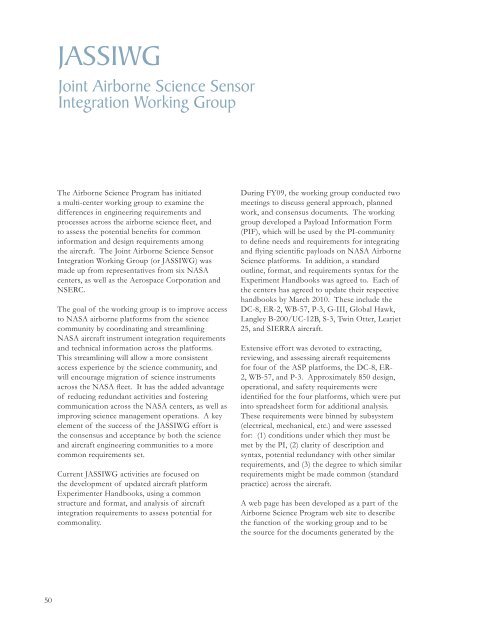2009 Annual Report - NASA Airborne Science Program
2009 Annual Report - NASA Airborne Science Program
2009 Annual Report - NASA Airborne Science Program
You also want an ePaper? Increase the reach of your titles
YUMPU automatically turns print PDFs into web optimized ePapers that Google loves.
JASSIWG<br />
Joint <strong>Airborne</strong> <strong>Science</strong> Sensor<br />
Integration Working Group<br />
The <strong>Airborne</strong> <strong>Science</strong> <strong>Program</strong> has initiated<br />
a multi-center working group to examine the<br />
differences in engineering requirements and<br />
processes across the airborne science fleet, and<br />
to assess the potential benefits for common<br />
information and design requirements among<br />
the aircraft. The Joint <strong>Airborne</strong> <strong>Science</strong> Sensor<br />
Integration Working Group (or JASSIWG) was<br />
made up from representatives from six <strong>NASA</strong><br />
centers, as well as the Aerospace Corporation and<br />
NSERC.<br />
The goal of the working group is to improve access<br />
to <strong>NASA</strong> airborne platforms from the science<br />
community by coordinating and streamlining<br />
<strong>NASA</strong> aircraft instrument integration requirements<br />
and technical information across the platforms.<br />
This streamlining will allow a more consistent<br />
access experience by the science community, and<br />
will encourage migration of science instruments<br />
across the <strong>NASA</strong> fleet. It has the added advantage<br />
of reducing redundant activities and fostering<br />
communication across the <strong>NASA</strong> centers, as well as<br />
improving science management operations. A key<br />
element of the success of the JASSIWG effort is<br />
the consensus and acceptance by both the science<br />
and aircraft engineering communities to a more<br />
common requirements set.<br />
Current JASSIWG activities are focused on<br />
the development of updated aircraft platform<br />
Experimenter Handbooks, using a common<br />
structure and format, and analysis of aircraft<br />
integration requirements to assess potential for<br />
commonality.<br />
During FY09, the working group conducted two<br />
meetings to discuss general approach, planned<br />
work, and consensus documents. The working<br />
group developed a Payload Information Form<br />
(PIF), which will be used by the PI-community<br />
to define needs and requirements for integrating<br />
and flying scientific payloads on <strong>NASA</strong> <strong>Airborne</strong><br />
<strong>Science</strong> platforms. In addition, a standard<br />
outline, format, and requirements syntax for the<br />
Experiment Handbooks was agreed to. Each of<br />
the centers has agreed to update their respective<br />
handbooks by March 2010. These include the<br />
DC-8, ER-2, WB-57, P-3, G-III, Global Hawk,<br />
Langley B-200/UC-12B, S-3, Twin Otter, Learjet<br />
25, and SIERRA aircraft.<br />
Extensive effort was devoted to extracting,<br />
reviewing, and assessing aircraft requirements<br />
for four of the ASP platforms, the DC-8, ER-<br />
2, WB-57, and P-3. Approximately 850 design,<br />
operational, and safety requirements were<br />
identified for the four platforms, which were put<br />
into spreadsheet form for additional analysis.<br />
These requirements were binned by subsystem<br />
(electrical, mechanical, etc.) and were assessed<br />
for: (1) conditions under which they must be<br />
met by the PI, (2) clarity of description and<br />
syntax, potential redundancy with other similar<br />
requirements, and (3) the degree to which similar<br />
requirements might be made common (standard<br />
practice) across the aircraft.<br />
A web page has been developed as a part of the<br />
<strong>Airborne</strong> <strong>Science</strong> <strong>Program</strong> web site to describe<br />
the function of the working group and to be<br />
the source for the documents generated by the<br />
50











